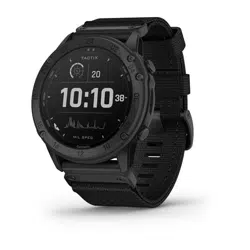Loading ...
Loading ...
Loading ...

NOTE: Most long range rifle bullets are closer to the G7
standard.
Profile Fields, Gun Properties
Muzzle Velocity: The speed of the bullet as it leaves the
muzzle. Input field.
NOTE: This field is required for accurate calculations by the
shooting solution. If you calibrate the muzzle velocity, this
field may be updated automatically for a more accurate firing
solution.
Output Units: The output units of measure. A milliradian (mil) is
3.438 inches at 100 yards. A minute of angle (MOA) is 1.047
inches at 100 yards.
Sight Height: The distance from the center axis of the rifle
barrel to the center axis of the scope. Input field.
TIP: You can easily determine this value by measuring from
the top of the bolt to the center of the windage turret, and
adding half of the diameter of the bolt.
SSF - Elevation: A linear multiplier that accounts for vertical
scaling. Not all rifle scopes track perfectly, so the ballistics
solution requires a correction to scale according to a
particular rifle scope. For example, if a turret is moved 10 mil
but the impact is 9 mil, the sight scale is 0.9. Input field.
SSF - Windage: A linear multiplier that accounts for horizontal
scaling. Not all rifle scopes track perfectly, so the ballistics
solution requires a correction to scale according to a
particular rifle scope. For example, if a turret is moved 10 mil
but the impact is 9 mil, the sight scale is 0.9. Input field.
Twist Rate: The distance it takes for the rifling of your barrel to
make one full rotation. Rifle twist is often provided by the gun
or barrel manufacturer. Input field.
Zero Height: An optional modification to impact elevation at
zero range. This is often used when adding a suppressor or
using a subsonic load. For example, if you add a suppressor
and your bullet impacts the target 1 inch higher than
expected, your Zero Height is 1 inch. You must set this to
zero when you remove the suppressor. Input field.
Zero Offset: An optional modification to impact windage at zero
range. This is often used when adding a suppressor or using
a subsonic load. For example, if you add a suppressor and
your bullet impacts the target 1 inch to the left of the
expected impact, your Zero Offset is -1 inch. You must set
this to zero when you remove the suppressor. Input field.
Zero Range: The range at which the rifle was zeroed. Input
field.
Profile Fields, Gun Properties, Calibrate Muzzle Velocity
Range: The distance from the muzzle to the target. Input field.
TIP: You should enter a value as close as possible to the
range suggested in the shooting solution. This is the range
where the bullet slows to Mach 1.2 and begins to enter the
transonic range.
True Drop: The actual distance the bullet falls while in flight to
the target, displayed in milliradians (mil) or minute of angle
(MOA). Input field.
Profile Fields, Gun Properties, Calibrate Drop Scale Factor
Range: The range from which you are shooting. Input field.
TIP: This range should be within 90% of the recommended
range suggested in the shooting solution. Values that are
less than 80% of the recommended range will not provide a
valid adjustment.
True Drop: The actual distance the bullet falls when fired at a
specific range, displayed in milliradians (mil) or minute of
angle (MOA). Input field.
VO2 Max. Standard Ratings
These tables include standardized classifications for VO2 max. estimates by age and gender.
Males Percentile 20–29 30–39 40–49 50–59 60–69 70–79
Superior 95 55.4 54 52.5 48.9 45.7 42.1
Excellent 80 51.1 48.3 46.4 43.4 39.5 36.7
Good 60 45.4 44 42.4 39.2 35.5 32.3
Fair 40 41.7 40.5 38.5 35.6 32.3 29.4
Poor 0–40 <41.7 <40.5 <38.5 <35.6 <32.3 <29.4
Females Percentile 20–29 30–39 40–49 50–59 60–69 70–79
Superior 95 49.6 47.4 45.3 41.1 37.8 36.7
Excellent 80 43.9 42.4 39.7 36.7 33 30.9
Good 60 39.5 37.8 36.3 33 30 28.1
Fair 40 36.1 34.4 33 30.1 27.5 25.9
Poor 0–40 <36.1 <34.4 <33 <30.1 <27.5 <25.9
Data reprinted with permission from The Cooper Institute. For more information, go to www.CooperInstitute.org.
FTP Ratings
These tables include classifications for functional threshold
power (FTP) estimates by gender.
Males Watts per Kilogram (W/kg)
Superior 5.05 and greater
Excellent From 3.93 to 5.04
Good From 2.79 to 3.92
Fair From 2.23 to 2.78
Untrained Less than 2.23
Females Watts per Kilogram (W/kg)
Superior 4.30 and greater
Excellent From 3.33 to 4.29
Good From 2.36 to 3.32
Fair From 1.90 to 2.35
Untrained Less than 1.90
FTP ratings are based on research by Hunter Allen and Andrew
Coggan, PhD, Training and Racing with a Power Meter
(Boulder, CO: VeloPress, 2010).
Appendix 51
Loading ...
Loading ...
Loading ...
